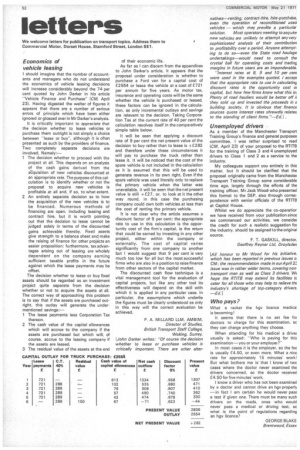Economics of vehicle leasing
Page 54

If you've noticed an error in this article please click here to report it so we can fix it.
I should imagine that the number of accountants and managers who do not understand the economics of vehicle leasing decisions will increase considerably beyond the 74 per cent quoted by John Darker in his article "Vehicle Finance and Purchase" (CM, April 23). Having digested the welter of figures it appears that there are a number of serious errors of principle which have been either ignored or glossed over in Mr Darker's analysis.
It is critically important to appreciate that the decision whether to lease vehicles or purchase them outright is not simply a choice between "lease or buy'', although it is often presented as such by the providers of finance. Two completely separate decisions are involved. Namely: 1 The decision whether to proceed with the project at all. This depends on an analysis of the cash gains derived from the atquisition of new vehicles discounted at an appropriate rate. The purpose of this calculation is to identify whether or not the proposal to acquire new vehicles is profitable at all and, if so, to what extent.
2 An entirely separate decision as to how the acquisition of the new vehicles is to be financed. Numerous methods of financing are open, including leasing and contract hire, but it is worth pointing out that the decision to lease cannot be judged solely in terms of the discounted gains achievable thereby. Fixed assets give strength to a balance sheet and make the raising of finance for other projects an easier proposition; furthermore, tax advantages arising out of leasing are vvhoiely dependent on the company earning sufficient taxable profits in " the future . against which the lease payments may be offset.
The decision whether to lease or buy fixed assets should be regarded as an investment project quite separate from the decision whether or not to acquire the assets at all, The correct way of approaching this problem is to say that if the assets are purchased outright, this outlay will generate the undermentioned savings:— 1 The lease payments less Corporation Tax thereon.
2 The cash value of the capital allowances which will accrue to the company if the assets are purchased but which will, of course, accrue to the leasing company if the assets are leased.
3 The residual value of the assets at the end of their economic life.
As far as I can discern from the appendices to John Darkers article, it appears that the proposal under consideration is whether to purchase a Ford van for a capital cost of £2554 or lease the vehicle at a cost of £721 per annum for five years. As motor tax, insurance and operating costs will be the same whether the vehicle is purchased or leased, these factors can be ignored in the calculation, as only incremental outlays and savings are relevant to the decision. Taking Corporation Tax at the current rate of 40 per cent the calculation resolves itself in the comparatively simple table below.
It will be seen that applying a discount rate of 9 per cent the net present value of the decision to buy rather than to lease is +£282 and therefore under these circumstances it will pay to purchase the truck rather than lease it. It will be noticed that the cost of the spare vehicle is not included in the calculation as it is assumed that this will be used to generate revenue in its own right. Even if the spare vehicle was used literally only to replace the primary vehicle when the latter was unavailable, it will be seen that the net present value is still +£27, or, to look at it the other way round, in this case the purchasing company could own both vehicles at less than the cost of renting the primary vehicle.
It is not clear why the article assumes a discount factor of 9 per cent; the appropriate rate to use in this calculation is the opportunity cost of the firm's capital, ie the return that .could be earned by investing in any other project, either within the company or externally. The cost of capital varies significantly from one company to another but I would suggest that 9 per cent is very much too low for all but the most successful firms who are also in a position to raise finance from other sectors of the capital market.
The discounted cash flow technique is a vital management tool for the evaluation of capital projects, but like any other tool its effectiveness will depend on the skill with which it is applied in any particular case. In particular, the assumptions which underlie the figures must be clearly understood as only in this way will the correct evaluation be achieved.
P. A. MILLARD LLM, AMBIM, Director of Studies, British Transport Staff College, Woking, Surrey. [John Darker writes: "Of course the decision whether to lease or purchase vehicles is critically important. There are other alter natives—renting, contract-hire, hire-purchase, even the operation of reconditioned used vehicles — which may provide a particular solution. Most operators needing to acquire new vehicles are unlikely to attempt anyvery sophisticated analysis of their contribution to profitability over a period. Anyone attempting to do so—even the State road haulage undertakings—would need to consult the crystal ball for operating costs and trading margins in future years are an imponderable.
"Interest rates at a 9 and 10 per cem were used in the examples quoted. I accep that the appropriate rate to use in calculating discount rates is the opportunity cost or capital, but how few firms know what this /Si Plenty of road hauliers would be better off h they sold up and invested the proceeds in a building society. It is obvious that finance sources quote interest rates shrewdly relates to the standing of client firms.------Ed.1 ,






























































































































